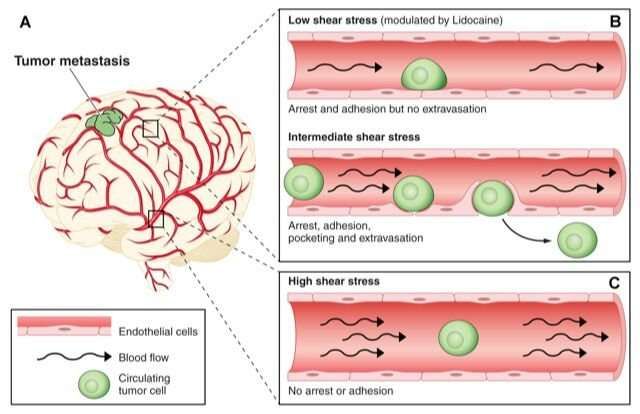Release date: 2018-04-16
Scientists have long suspected that blood flow plays a role in the process of tumor metastasis. But a recent study in zebrafish and humans has shown that circulating blood flow affects the location where circulating tumor cells (CTCs) are eventually captured by blood vessels and enter the tissue, where cancer forms metastases.

Image source: Jacky Goetz et al.
In a recent study published in the Developmental Cell, scientists from the French National Institute of Health and Medical Research (INSERM) found that in a zebrafish embryo model, labeled CTCs can circulate throughout the blood vessel. The location at which tumor cells are captured is closely related to the blood flow velocity below 400-600 um/s. The primary goal of this study was to observe the important steps of blood flow to tumor metastasis - the effects of CTCs adhering to blood vessels and from the process of spilling blood vessels.
"A long-standing view in this area is that CTCs are forced to reside at the end of the capillaries due to the size limitations of the blood vessels," said Dr. Jacky G. Goetz, author of the study. "This study shows that tumor cells are retained not only because of physical size limitations, but also because blood flow has an important effect on the adhesion of CTCs on the vessel wall. I think this is an understanding of how and where tumor cells are transferred. Important point."
The researchers chose the zebrafish embryo model because its blood vessels were highly consistent. "This makes it easy to determine where all tumor cells are in their bodies after injection," Goetz said. The researchers folded all the pictures together to create a heat map of the location of the tumor cells in the blood vessels.
The researchers also found that blood flow is necessary for the process of tumor cell spillage. “When we performed time-delay imaging in the zebrafish model, we found that the endothelial cells in the tumor cell-holding position would curl. And blood flow is necessary for this step, without blood flow, the endothelial cells will not reshape. You The blood flow is required to keep the endothelial cells active so that they can remodel around the tumor cells."
They used a living-related microscope to determine these observations in mouse brain metastases.
The researchers then used these findings to study 100 patients who had metastases from different parts of the primary to the brain. As in the zebrafish model, they superimposed the location of the metastases to form a heat map. “We compared the location of the metastases with the perfusion map of the control population and found that these conditions are similar to those in the zebrafish, which are more likely to form at low perfusion levels.â€
The researchers believe that these findings suggest that blood flow to metastases controls where and how metastases are formed. Looking ahead, the researchers plan to study ways to inhibit the remodeling of endothelial cells in blood vessels, thereby affecting tumor cell overflow and inhibiting metastasis.
Reference materials:
Jacky G. Goetz et al. Hemodynamic Forces Tune the Arrest, Adhesion, and Extravasation of Circulating Tumor Cells. Developmental Cell, 2018; 45 (1): 33 DOI: 10.1016/j.devcel.2018.02.015
Source: Bio Valley
Thymosin is a hormone secreted from the thymus. Its primary function is to stimulate the production of T cells, which are an important part of the immune system. Thymosin also assists in the development of B cells to plasma cells to produce antibodies. In addition to its role as a major actin-sequestering molecule, Thymosin Beta 4 plays a role in tissue repair.
Aicar Powder,Adipotide Powder,Dermorphin Powders,Bodybuilding Raw Powder
Shaanxi YXchuang Biotechnology Co., Ltd , https://www.peptide-nootropic.com